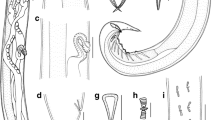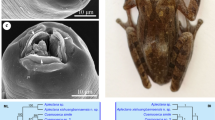Abstract
Nematodes of the genus Cosmocerca are commonly found in various amphibians in South Africa and in most cases are identified as C. ornata. However, after detailed morphological studies and molecular approaches, three new species of the genus were recently described from three different frogs in South Africa. In present study, we describe another new species – Cosmocerca goroensis parasitising the Northern Pygmy Toad Poyntonophrynus fenoulheti in Soutpansberg mountains, Limpopo province, South Africa. The new species is characterised by prominent sex dimorphism, wide lateral alae, numerous somatic papillae in both sexes, and wide triangularly shaped gubernaculum and simple prominent spicules in males. Cosmocerca goroensis n. sp. distinguished from congeners, previously reported in Southern Africa by the shape of the gubernaculum and arrangement of somatic papillae in males. Morphological differences were confirmed by molecular analysis based on fragments of the 28S gene. Phylogenetic analysis based on the 28S gene fragments, including C. goroensis n. sp. and newly obtained sequence of C. ornata from Pelophylax lessonae from Ukraine, supported previously known data of closer relationships between species of Cosmocerca and Aplectana and more distant with Cosmocercoides spp.




Similar content being viewed by others
References
Alcantara, E. P., Ebert, M. B., Müller, M. I., Úngari, L. P., Ferreira-Silva, C., Emmerich, E., Santos, A.L.Q., O’Dwyer, L. H. & Da Silva, R. J. (2022). First molecular assessment on Cosmocerca spp. from Brazilian anurans and description of a new species of Cosmocerca (Ascaridomorpha: Cosmocercoidea) from the white-spotted humming frog Chiasmocleis albopunctata (Boettger, 1885) (Anura: Microhylidae). Journal of Helminthology, 96 (e64), 1–8. https://doi.org/10.1017/S0022149X22000517
Baker, M. Rr. (1981). Cosmocercid nematode parasites from frogs of Southern Africa. Museum national d'Histoire naturelle, 24(1), 25–32. https://doi.org/10.4102/koedoe.v24i1.616
Chen, H.-X., Zhang, L.-P., Feng, Y.-Y. & Li, L. (2020). Integrated evidence reveals a new species of Cosmocerca (Ascaridomorpha: Cosmocercoidea) from the Asiatic toad Bufo gargarizans Cantor (Amphibia: Anura). Parasitology Research, 119, 1795–1802. https://doi.org/10.1007/s00436-020-06687-3
Chen, H.-X., Gu, X.-H., Ni, X.-F. & Li, L. (2021a). Description of a new species of Aplectana (Nematoda: Ascaridomorpha: Cosmocercidae) using an integrative approach and preliminary phylogenetic study of Cosmocercidae and related taxa. Parasites & Vectors, 14:165. https://doi.org/10.1186/s13071-021-04667-9
Chen, H.-X., Ni, X.-F., Gu, X.-H., Sinch, U. & Li, L. (2021b). Morphology, genetic characterization and phylogeny of Aplectana dayaoshanensis n. sp. (Nematoda: Ascaridida) from frogs. Infection, Genetics and Evolution, 96, 1–9. https://doi.org/10.1016/j.meegid.2021.105123
Dujardin, D. N. (1845). Histoire naturelle des helminthes ou vers intestinaux. Paris. 658.
Folmer, O., Black, M., Hoeh, W., Lutz, R., & Vrijenhoek, R. (1994). DNA primers for amplification of mitochondrial cytochrome c oxidase subunit I from diverse metazoan invertebrates. Molecular Marine Biology and Biotechnology, 3, 294–299.
Gibbons, L. (2010). Keys to the nematode parasites of vertebrates. Supplementary volume. CAB International, Oxon, 416. https://doi.org/10.1079/9781845935719.0003
Harnoster, F., Du Preez, L. & Svitin, R. (2022). Three new species of Cosmocerca Diesing, 1861 (Nematoda: Cosmocercidae) parasitising frogs Cacosternum boettgeri Boulenger, 1882, Kassina senegalensis Dumeril and Bibron, 1841 and Phrynomantis bifasciatus Smith, 1847 from South Africa. Parasitology Research, 121, 563–571. https://doi.org/10.1007/s00436-021-07390-7
Rebêlo, G. L., Santos, A. N., Travares-Costa, L. F. S., Dias-Souza, M. R., Müller, M. I., Jesus, R. F., Costa-Campos, C. E., Dos Santos, J. N. & Melo, F. T. V. (2023). Morphological and molecular characterization of Cosmocercoides amapari n. sp. (Nematoda: Cosmocercidae), parasitic in hylid frogs from the Brazilian Amazon. Parasitology, 150(3), 286–296. https://doi.org/10.1017/S0031182022001767
Sou, S. K., Sow, K. K. & Nandi, A. P. (2019). Redescription of Cosmocerca ornata (Dujardin, 1845) Diesing, 1861 (Nematoda: Cosmocercidae) from Ranid Frogs of West Bengal, India. Proceedings of the Zoological Society, 72, 372–379. https://doi.org/10.1007/s12595-018-0279-6
Tamura, K., Stecher, G. & Kumar, S. (2021) MEGA11: Molecular Evolutionary Genetics Analysis version 11. Molecular Biology and Evolution, 38, 3022–3027.
Tkach, V. V., Kuzmin, Y., & Snyder, S. D. (2014). Molecular insight into systematics, host associations, life cycles and geographic distribution of the nematode family Rhabdiasidae. International Journal for Parasitology, 44(5), 273–284. https://doi.org/10.1016/j.ijpara.2013.12.005
Travassos, L. (1931) Note préliminaire sur les Cosmocercidae d’Europe. Compte rendu des Séances de la Société de Biologie, 107, 175–176.
Yildirimhan, H. S., Bursey, C. R. & Goldberg, S. R. (2009). Helminth parasites of the Caucasian parsley frog, Pelodytes caucasicus, from Turkey. Comparative Parasitology, 76, 247–257. https://doi.org/10.1654/4376.1.
Acknowledgements
The study was financially supported by Grant of the National Academy of Sciences of Ukraine for research laboratories/groups of young scientists of the National Academy of Sciences of Ukraine for conducting research in the priority areas of development of science and technology in 2022-2023. Roman Svitin and Yuriy Kuzmin wish to express their sincere thanks to the Armed Forces of Ukraine for the ability to continue research in Ukraine even during the full-scale Russian aggression.
Author information
Authors and Affiliations
Contributions
RS, TN, FH, YK and LdP collected amphibians and nematodes. RS, FH, TN and YK completed the morphological part of the species study. FH, TN and RS completed the molecular part of the study. All authors reviewed the text of the manuscript and images.
Corresponding author
Ethics declarations
Conflict of interest
The authors declare that they have no conflict of interest.
Ethical approval
All applicable institutional, national and international guidelines for the care and use of animals were followed. North-West University ethics approval no NWU-00380-16-A5.
Additional information
Publisher's Note
Springer Nature remains neutral with regard to jurisdictional claims in published maps and institutional affiliations.
Rights and permissions
Springer Nature or its licensor (e.g. a society or other partner) holds exclusive rights to this article under a publishing agreement with the author(s) or other rightsholder(s); author self-archiving of the accepted manuscript version of this article is solely governed by the terms of such publishing agreement and applicable law.
About this article
Cite this article
Svitin, R., Kuzmin, Y., Harnoster, F. et al. Cosmocerca goroensis n. sp. (Nematoda: Cosmocercidae) from South Africa and its phylogenetic relationships with other cosmocercids based on partial 28S sequences. Syst Parasitol 100, 601–610 (2023). https://doi.org/10.1007/s11230-023-10109-0
Received:
Accepted:
Published:
Issue Date:
DOI: https://doi.org/10.1007/s11230-023-10109-0




